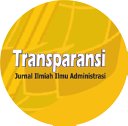Analisis Efektivitas Hukum dalam Kebijakan Pengawasan di Bidang Kepabeanan dan Cukai pada Kantor Pengawasan dan Pelayanan Bea dan Cukai Tipe Madya Pabean C Jayapura
DOI:
https://doi.org/10.31334/transparansi.v4i2.3005Keywords:
Legal Effectiveness, Supervision of Customs, Excise,Abstract
Based on the Law Number 17 of 2006 concerning Amendments to the Law Number 10 of 1995 concerning Customs, the implementation of customs and excise taxation activities adheres to a self-assessment system. Thus, there is a need for a balance related to the supervision of the implementation of the law. The supervision referred to is all supervisory activities in the customs and excise sector as regulated in the Regulation of the General Directorate of Customs and Excise Number P-17/BC/2020 concerning Procedures for Supervision in the Customs and Excise Sector. The objective of this study was to find out and analyze the implementation of supervision based on the Regulation of the General Director of Customs and Excise Number P-17/BC/2020 and the effectiveness of the law in implementing this policy at the Customs and Excise Service Office of Customs and Excise of the Middle Type C Customs Jayapura from 2020 to 2022. The method applied in this research was normative-empirical law with a statute approach and a case approach. The techniques used for collecting legal materials were a bibliography study, a document study, and a file or record study. Then, the technique of analyzing legal materials utilizing the interpretation of legal materials that had been processed. The results of the study showed that the implementation of customs and excise supervision has been following with the Regulation of the General Director of Customs and Excise Number P-17/BC/2020 with KPI achievement results ranging from 75% to 100% of the targets set from 2020 to 2022. Then, the legal effectiveness in supervision in the sector of customs and excise at the Customs and Excise Service Office of Customs and Excise of the Middle Type C Customs Jayapura from 2020 to 2022, being reviewed from the five indicators, was still not optimal, because there were still several obstacles in each of these indicators.References
Buku :
Achmad Kadir. 2015. Penindakan dan Pengawasan di Bidang Cukai. Jakarta:Kementerian Keuangan Republik Indonesia Badan Pendidikan dan Pelatihan Keuangan Pusdiklat Bea dan Cukai
Bambang Semedi. 2015. Penindakan dan Pengawasan di Bidang Kepabeanan. Jakarta:Kementerian Keuangan Republik Indonesia Badan Pendidikan dan Pelatihan Keuangan Pusdiklat Bea dan Cukai
Edi Slamet Irianto. 2022. Politik Hukum Pajak Indonesia (Dalam Praktik dan Kontemporer). Bogor:Halaman Moeka Publishing
Johnny Ibrahim. 2008.Teori dan Motodologi Penelitian Hukum Normatif. Malang:Bayu Media Publishing
Muhaimin. 2020. Metode Penelitian Hukum. Mataram:Mataram University Press(Cetakan Pertama)
Peter Mahmud Marzuki. 2010. Penelitian Hukum. Jakarta:Kencana Prenada
Ronny Hanitijo Soemitro. 2010. Dualisme Penelitian Hukum (Normatif dan Empiris). Yogyakarta:Pustaka Pelajar
R. Santoso Brotodihardjo. 2010. Pengantar Ilmu Hukum Pajak. Bandung:PT Refika Aditama
Soerjono Soekanto. 1983. Penegakan Hukum. Bandung:Bina Cipta
Soerjono Soekanto dan Sri Mamudji.2003. Penelitian Hukum Normatif,Suatu Tinjauan Singkat. Jakarta:PT. Radja Grafindo Persada
Soerjono Soekanto. 2008. Faktor-Faktor yang Mempengaruhi Penegakan Hukum. Jakarta:PT. Raja Grafindo Persada
Peraturan :
Peraturan Direktur Jenderal Bea dan Cukai Nomor P-17/BC/2020 tentang Tata Laksana Pengawasan di Bidang Kepabeanan dan Cukai
Downloads
Published
Issue
Section
License

This work is licensed under a Creative Commons Attribution-ShareAlike 4.0 International License
Please find the rights and licenses in Transparansi : Jurnal Ilmiah Ilmu Administrasi By submitting the article/manuscript of the article, the author(s) agree with this policy. No specific document sign-off is required.
- License
The commercial use of the article will be governed by the Creative Commons Attribution license as currently displayed on Creative Commons Attribution-ShareAlike 4.0 International License.
2. Author(s)' Warranties
The author warrants that the article is original, written by stated author(s), has not been published before, contains no unlawful statements, does not infringe the rights of others, is subject to copyright that is vested exclusively in the author and free of any third party rights, and that any necessary written permissions to quote from other sources have been obtained by the author(s).
3. User Rights
Transparansi : Jurnal Ilmiah Ilmu Administrasi spirit is to disseminate articles published are as free as possible. Under the Creative Commons license, Transparansi : Jurnal Ilmiah Ilmu Administrasi permits users to copy, distribute, display, and perform the work for non-commercial purposes only. Users will also need to attribute authors and Transparansi : Jurnal Ilmiah Ilmu Administrasi on distributing works in the journal and other media of publications.
4. Co-Authorship
If the article was jointly prepared by more than one author, any authors submitting the manuscript warrants that he/she has been authorized by all co-authors to be agreed on this copyright and license notice (agreement) on their behalf, and agrees to inform his/her co-authors of the terms of this policy. Transparansi : Jurnal Ilmiah Ilmu Administrasi will not be held liable for anything that may arise due to the author(s) internal dispute. Transparansi : Jurnal Ilmiah Ilmu Administrasi will only communicate with the corresponding author.
5. Miscellaneous
Transparansi : Jurnal Ilmiah Ilmu Administrasi will publish the article (or have it published) in the journal if the article’s editorial process is successfully completed. Transparansi : Jurnal Ilmiah Ilmu Administrasi editors may modify the article to a style of punctuation, spelling, capitalization, referencing and usage that deems appropriate. The author acknowledges that the article may be published so that it will be publicly accessible and such access will be free of charge for the readers as mentioned in point 3.
Every accepted manuscript should be accompanied by "Copyright Transfer Agreement"prior to the article publication.











